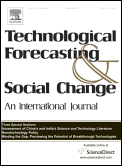TFSC is the world’s premier scholarly journal on technology assessment and futures. With its long history and a current download rate of 275,000 articles per year, TFSC also is one of Elsevier’s most widely read international journals.
TFSC’s first issue appeared in June 1969, with a lead article by Nobel laureate Dennis Gabor. Tom Schelling (winner of the 2005 Nobel Memorial Prize in Economics), US Secretary of the Air Force Robert Seamans, Jr., and former US National Security Advisor Walt Rostow are among the other luminaries who have contributed papers over the years. The journal benefits from a distinguished Advisory Board.
Technological For
 ecasting&Social Change publishes articles that deal directly with the methodology and practice of technological forecasting as a planning tool, or the analysis of the interaction of technology with the social, behavioral and environmental aspects of integrative planning. Perhaps the most seminal paper in the early years of the journal was JC Fisher and RH Pry’s ”A Simple Substitution Model of Technological Change“ (issue 3/1, 1971). (I've riffed on the Fisher-Pry curve here at Science 2.0.) Delphi forecasting has been a popular subject throughout the journal’s history. Other topics underpinning TFSC papers include long wave cycles, scenario methods, roadmapping, and national/regional innovation systems, with applications in energy, environment, high-tech, and space technologies.
ecasting&Social Change publishes articles that deal directly with the methodology and practice of technological forecasting as a planning tool, or the analysis of the interaction of technology with the social, behavioral and environmental aspects of integrative planning. Perhaps the most seminal paper in the early years of the journal was JC Fisher and RH Pry’s ”A Simple Substitution Model of Technological Change“ (issue 3/1, 1971). (I've riffed on the Fisher-Pry curve here at Science 2.0.) Delphi forecasting has been a popular subject throughout the journal’s history. Other topics underpinning TFSC papers include long wave cycles, scenario methods, roadmapping, and national/regional innovation systems, with applications in energy, environment, high-tech, and space technologies. The journal has grown from four issues per year totaling 450 pages in Vol. 1(1969-70) to nine issues/year totaling 1512 pages in the 2009 Vol. 76. Hardcopy subscriptions are about evenly divided among North America (29%), Europe (34%), and Asia (31%).
However, readers find downloading individual TFSC articles more and more appealing, with downloads growing from 109,685 in 2006 to 268,000 in 2009, with more than 275,000 expected when 2010 tallies appear. Individuals in 89 countries requested downloads in 2008. The countries with the most downloads (in order) are the United States, China, United Kingdom, and the Netherlands. There has been striking growth in downloads from Iran, China, India, and Russia.
Article submissions have grown even faster than the page count. Though we must disappoint some hopeful authors, the quality of accepted papers is getting even better. The journal’s year-to-year impact factor (citation rate) has grown fourfold since 2004, and is now 1.78. Submissions to the journal, now originating equally from Europe, Asia and the Americas, have risen to 330 per year.
A comparative author survey in 2006 rated Technological Forecasting&Social Change above average in every category: refereeing speed, reputation, refereeing standard, impact factor, production speed, editor/board, publication services, and physical quality. According to Elsevier, ”it is excellent and rare to see“ such a result.
Consider subscribing, or perusing TFSC papers on ScienceDirect.com. Your institution may already connect to an aggregator like EBSCO, and this may include access to ScienceDirect. Submit a paper. Active researchers may volunteer as reviewers, helping us ensure the quality of TFSC’s published articles. Download a free issue, via the journal’s home page, and start – if you have not already – to be part of the Technological Forecasting&Social Change community.
I take over from TFSC Founding Editor Harold ”Hal“ Linstone. Hal, a German-born mathematician who worked at Lockheed and at the RAND Corporation before returning to academe, pioneered the Multiple Perspectives approach in systems science, and was an early developer, champion, and chronicler of the Delphi Method of technology forecasting. At the helm of the journal for 42 years, he drove the growth detailed above, making TFSC a publication read and quoted by policy makers worldwide. Key to this has been Hal’s emphasis on making the journal readable, and accessible to readers from multiple disciplines. I find most journals rather painful to read, but never TFSC.
I became TFSC’s Senior Editor in 2007. I’d been Associate Editor of TFSC since 1999, and a member of the journal’s editorial advisory board since 1996.
As for the ”how-to“ promised in this column’s title, I have no earthly idea. I would guess: Love the journal; volunteer; act like you know what you're doing, but take advice; live in the same city as the current editor so s/he can easily bounce ideas off you (Hal was at Portland State U when I was at Oregon Graduate Institute of Science and Technology; now we’re in Palm Desert and San Diego respectively); hone authoring, reviewing and editing skills (perhaps by writing regularly here at Science 2.0); and be lucky and ready. I truly have no idea how to follow Hal’s great act – I’ll just try with a little help from my friends.





Comments